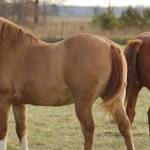Nutritional Management of Equine Metabolic Syndrome

Horses with equine metabolic syndrome (EMS) tend to be obese, insulin resistant, and predisposed to develop laminitis. Nutritional management of EMS cases is important to reduce body fat and the chances of laminitis. Grazing lush springtime pasture that is high in sugars and fructans (nonstructural carbohydrates or NSC) is an important risk factor to induce laminitis in equids affected with EMS.
In most cases, the weight-loss diet begins by removing concentrates from the horse’s ration and reducing grazing time on lush pasture. If possible, exercise should also be increased. Forage needs can be met by mature hay with low energy content that still provides some gut fill. As a general rule for weight loss, hay or other forages should not be fed at more than 1.5% of body weight. Forage can be fed in hay nets or hay bags with small holes to slow feed intake. Studies have shown that soaking hay has variable effects on removing water-soluble carbohydrates and may not be effective. Feeding forage in three or four small meals during the day will also help prevent boredom and stable vices. It is important to ensure that the diet continues to provide essential amino acids so that there is no loss of lean body mass. Whenever dietary intake is reduced, it is advisable to feed a vitamin and mineral balancer pellet to ensure adequate intake of other nutrients.
Some equids may consume up to 5% of their body weight per day if they are given free-choice access to forage. It is important to weigh feed and forage so that the owner can accurately know how much is being fed and dietary changes can be made accordingly. Increased exercise and turnout must be balanced with reduced pasture intake, especially if pasture is lush and fast-growing. Grazing muzzles have been shown to be very effective to reduce pasture intake and still allow the horse to exercise. Simply reducing turnout time may not reduce pasture intake, especially in ponies. In one study, obese ponies did not lose weight when turned out for 12 hours per day, probably because they ate more while turned out. Another study showed that ponies could eat 40% of their expected daily dry matter intake or 1% of their body weight when turned out onto pasture for only 3 hours.
With dietary restriction and increased exercise, some equids may have noticeable weight loss within 2 to 3 months. Others, however, can be extremely difficult to trim down despite a restricted diet. Research in ponies and other species indicates that a loss of 0.5% of body weight per week is reasonable. Ideally, horses on diets should be weighed and assigned body condition scores (BCS) every two weeks to monitor progress. Body condition score estimates fat mass and, at least initially, may not be a good indicator of weight loss. One study in obese ponies losing weight found that BCS did not change, although ponies lost approximately 12% of their body weight over a 12-week period, and neck, heart girth, and belly circumference decreased. In another study, BCS did change when there was an 18% weight loss. Much of the initial weight loss is caused by decreased gut fill and owners become frustrated when weight loss does not continue. Studies have shown that BCS may not change for the first few months, despite measurable weight loss. It is important to continue to restrict feed for the horse’s current weight rather than its initial obese weight.
Some horses with EMS may not be obese or need to gain weight. In these equids, beet pulp, corn oil, or a low-NSC feed may be fed to provide additional dietary energy. Generally, these feeds have a low glycemic response and do not complicate insulin resistance.
Geor, R.J. 2012. Equine metabolic syndrome: Nutritional management. In: Proc. Am. Coll. Vet. Intern. Med. 111-113.








